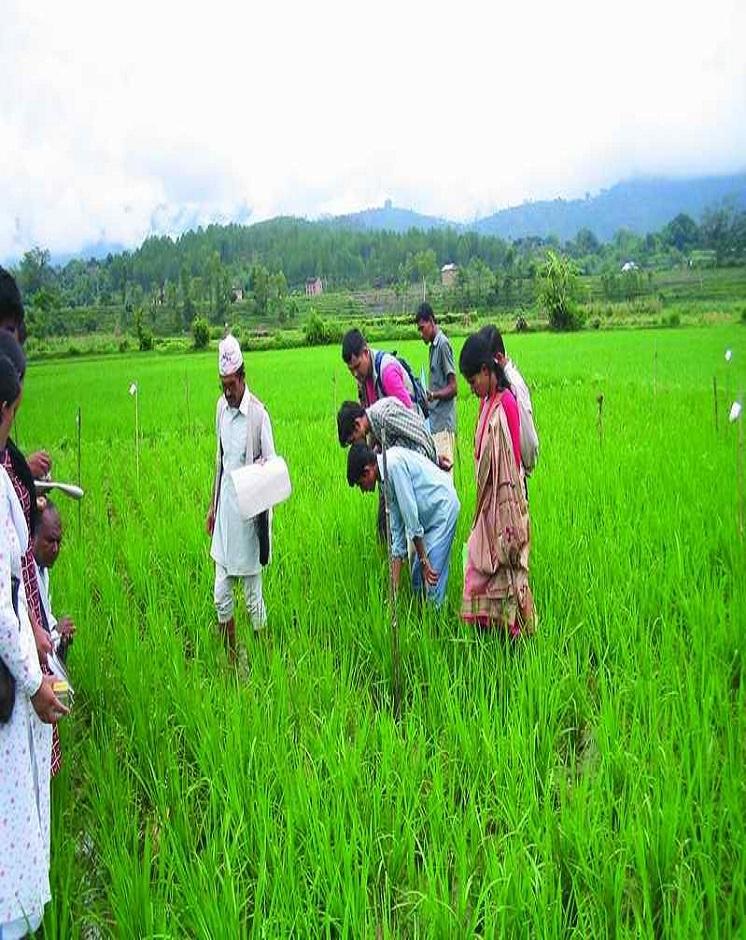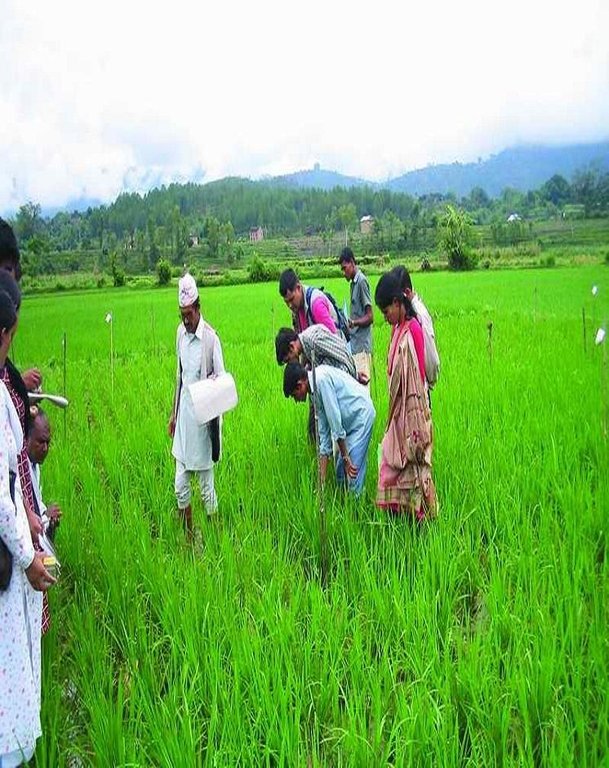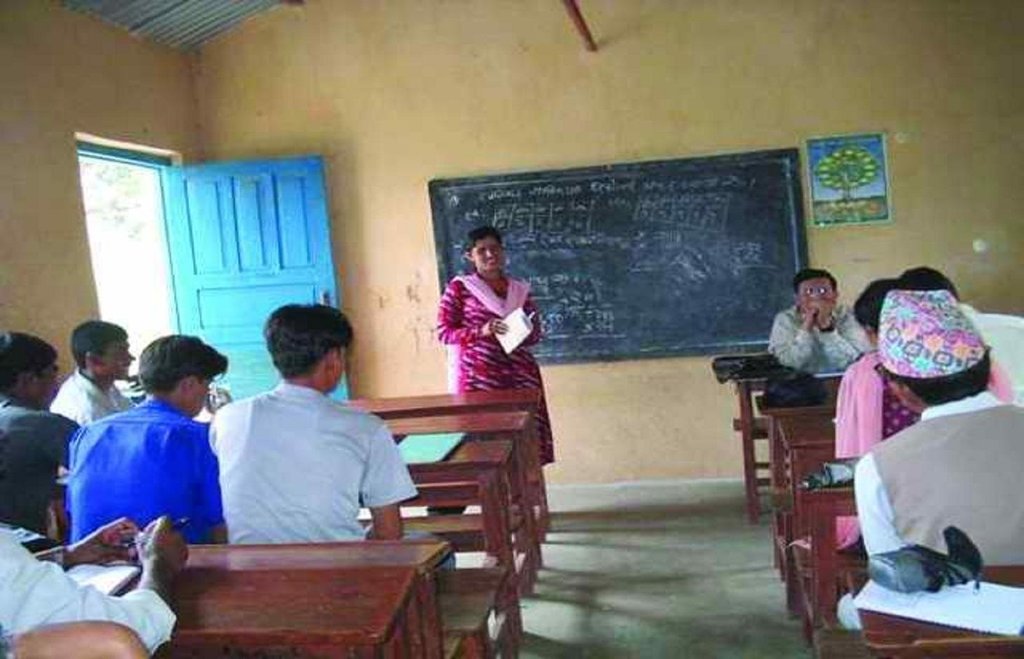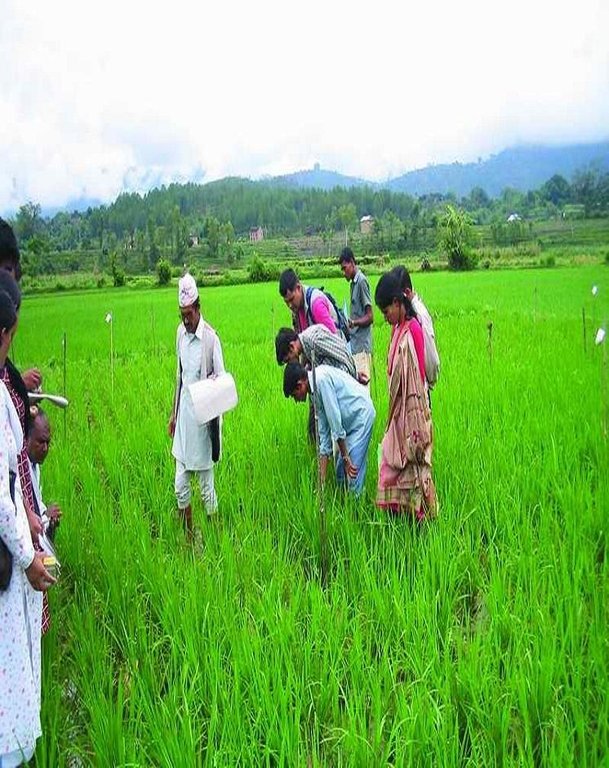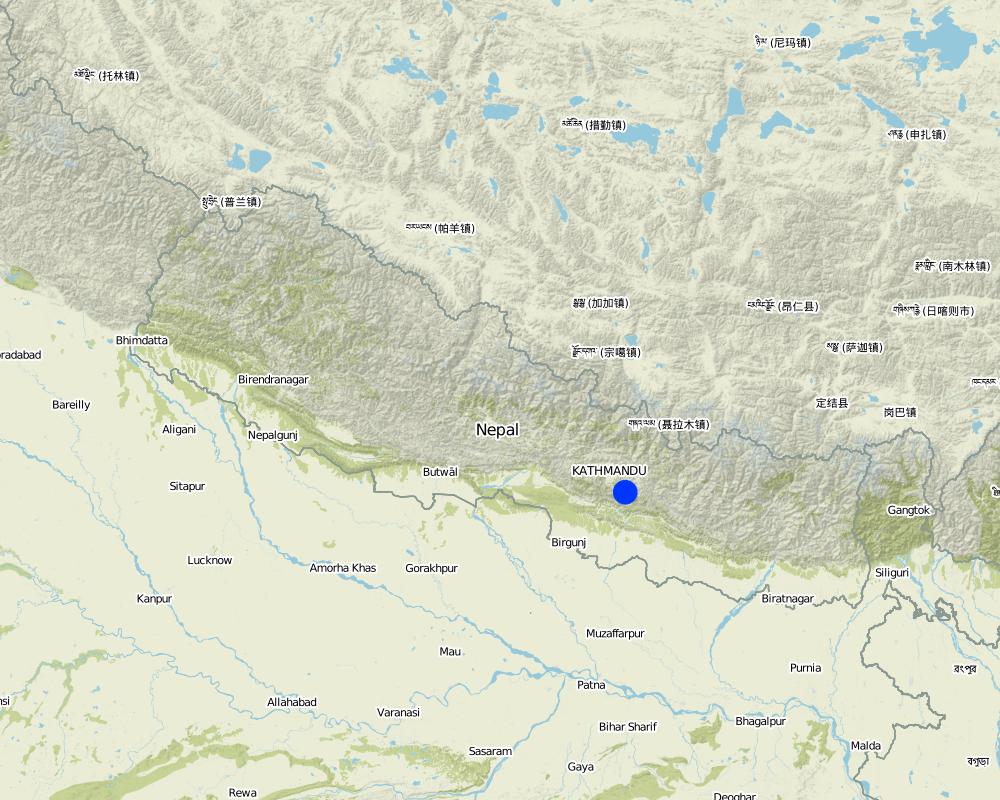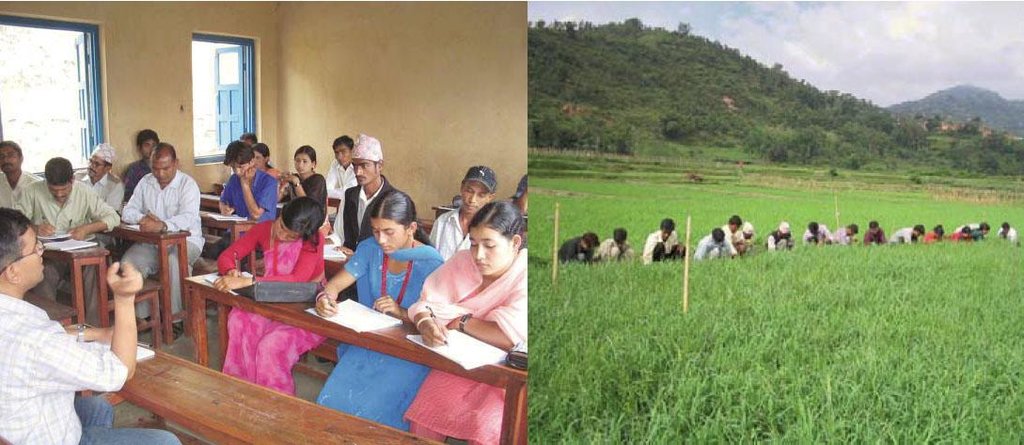Evaluation of the System of Rice Intensification through participatory research and development [เนปาล]
- ผู้สร้างสรรค์:
- การอัพเดท:
- ผู้รวบรวม: Madhav Dhakal
- ผู้เรียบเรียง: –
- ผู้ตรวจสอบ: Fabian Ottiger
Sahabhagitamulak anusandhan ra bikas dwara dhan uttpadan bridhhi garne tarika ko mulyankan (Nepali)
approaches_2550 - เนปาล
ดูส่วนย่อย
ขยายทั้งหมด ย่อทั้งหมด1. ข้อมูลทั่วไป
1.2 รายละเอียดที่ติดต่อได้ของผู้รวบรวมและองค์กรที่เกี่ยวข้องในการประเมินและการจัดเตรียมทำเอกสารของแนวทาง
ผู้เชี่ยวชาญ SLM:
ชื่อของโครงการซึ่งอำนวยความสะดวกในการทำเอกสารหรือการประเมินแนวทาง (ถ้าเกี่ยวข้อง)
CDE Centre for Development and Environment (CDE Centre for Development and Environment) - สวิตเซอร์แลนด์ชื่อของโครงการซึ่งอำนวยความสะดวกในการทำเอกสารหรือการประเมินแนวทาง (ถ้าเกี่ยวข้อง)
ICIMOD International Centre for Integrated Mountain Development (ICIMOD) - เนปาล1.3 เงื่อนไขที่เกี่ยวข้องกับการใช้ข้อมูลที่ได้บันทึกไว้ผ่านทาง WOCAT
ผู้รวบรวมและวิทยากรหลักยอมรับเงื่อนไขเกี่ยวกับการใช้ข้อมูลที่ถูกบันทึกผ่านทาง WOCAT:
ใช่
1.4 การอ้างอิงถึงแบบสอบถามเรื่องเทคโนโลยี SLM
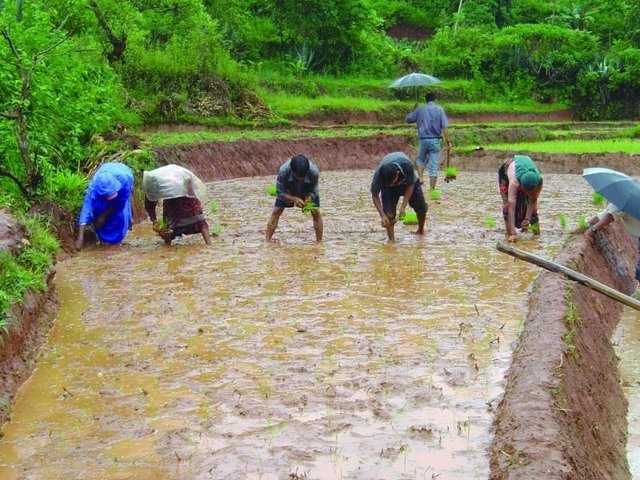
System of Rice Intensification [เนปาล]
A method for increasing the productivity of rice by changing the management of plants, soil, water, and nutrients.
- ผู้รวบรวม: Madhav Dhakal
2. คำอธิบายของแนวทาง SLM
2.1 การอธิบายแบบสั้น ๆ ของแนวทาง
Conducting participatory action research with farmers and district level line agencies for demonstrating, disseminating and scaling up SRI
2.2 การอธิบายอย่างละเอียดของแนวทาง
การอธิบายอย่างละเอียดของแนวทาง:
Aims / objectives: PARDYP pilot tested SRI in the Spice Crop Development Centre (SCDC) at Tamaghat, Kavrepalanchok in 2002. The positive results led the technique to be tried out in 25 farmer’s fields in 2004 to evaluate whether SRI was technically feasible in the Himalayan middle mountains. Based on farmers’ interests and to promote SRI systematically, PARDYP organised interaction programmes between farmers who had and had not used SRI, village level group discussions, farmer-to-farmer visits and farmer-led on-site monitoring and evaluation in 2002, 2003 and 2004.
Methods: In 2005, the emphasis shifted to carrying out research with groups of farmers in a more systematic way and participatory rural appraisal methods and tools were used. The approach was called the SRI farmer field school (FFS) approach. Lead farmers (13 male and 6 female) were trained as SRI trainers and then facilitated village level farmer field schools for testing and promoting SRI. In 2005, SRI farmer field schools were run in 15 villages for about 100 farmers. Each school carried out hands-on training sessions to help farmers understand (1) the basic concepts of SRI and its practices, (2) methods for comparing traditional practices with SRI, and (3) how to observe, analyse and present findings more systematically. Monitoring and evaluation gathered both men’s and women’s perceptions. This also helped establish an informal farmer-learning network in the watershed. Village level discussions, farmer visits, and interaction with staff from the district agriculture offices continued. At the end of the on-farm experiments, a district level farmer’s day was organised to share the experiences gained.
Other important information: To promote wider understanding of the action research and encourage farmers to continue developing and adapting SRI, the project disseminated information about SRI through information, education and communication (IEC) materials aimed at community-level users, and a multi-media package on a CD ROM for the global audience and Nepali policy-makers and administrators. A national exchange workshop was held to share experiences from across the country on the use of SRI.
2.3 รูปภาพของแนวทาง
2.5 ประเทศ ภูมิภาค หรือสถานที่ตั้งที่ได้นำแนวทางไปใช้
ประเทศ:
เนปาล
ข้อมูลเฉพาะเพิ่มเติมของสถานที่ตั้ง:
Kavrepalanchowk/ Jhikhu Khola watershed
Map
×2.6 วันที่เริ่มต้นและสิ้นสุดของแนวทาง
การสิ้นสุดลง (ถ้าแนวทางไม่ได้ใช้อีกต่อไป):
2005
2.7 ประเภทของแนวทาง
- ใช้โครงงานหรือแผนงานเป็นฐาน
2.8 เป้าหมายหรือวัตถุประสงค์หลักของแนวทาง
The Approach focused mainly on SLM with other activities (Rice cultivation, watersaving, agronomic innovation)
- To demonstrate and evaluate the innovative SRI technique under local conditions with land users' participation. - To inform farmers about the basic concepts, associated principles, and technical know-how related to SRI. - To share knowledge gained on SRI with a wider audience. - To scale up the innovation across larger areas
The SLM Approach addressed the following problems: - Lack of systematic on-farm research for developing a technology that takes into account farmers' needs. - Weak institutional collaboration for technology development, dissemination and scaling up. - Poor soil fertility, limited crop production, and poor irrigation facilities
2.9 เงื่อนไขที่เอื้ออำนวยหรือเป็นอุปสรรคต่อการนำเทคโนโลยีภายใต้แนวทางนี้ไปปฏิบัติใช้
การมีไว้ให้หรือการเข้าถึงแหล่งการเงินและบริการ
- เป็นอุปสรรค
Government incentives lacking
Treatment through the SLM Approach: The innovation is cost effective and doesn't need additional inputs
การจัดตั้งระดับองค์กร
- เป็นอุปสรรค
Lack of cordination among land users
Treatment through the SLM Approach: Informal SRI farmers network established with trained human resources.
กรอบแนวทางในการดำเนินการด้านกฎหมาย (การถือครองที่ดิน สิทธิในการใช้ที่ดินและน้ำ)
- เอื้ออำนวย
The existing land ownership, land use rights / water rights greatly helped the approach implementation: The individual land use rights helped in implementing the technology as there were no conflicts among land users.
ความรู้เกี่ยวกับ SLM การเข้าถึงการสนับสนุนด้านเทคนิค
- เป็นอุปสรรค
It is not a priority area of line agencies
Treatment through the SLM Approach: Sharing of technical know how with concerned stakeholders
อื่นๆ
- เป็นอุปสรรค
lack of awareness
Treatment through the SLM Approach: Trainings, group discussions , field visits
3. การมีส่วนร่วมและบทบาทของผู้มีส่วนได้ส่วนเสียที่เกี่ยวข้อง
3.1 ผู้มีส่วนได้ส่วนเสียที่เกี่ยวข้องในแนวทางนี้และบทบาท
- ผู้ใช้ที่ดินระดับท้องถิ่นหรือชุมชนระดับท้องถิ่น
Spices Crop Development Centre and farmer groups
Women are generally busy with in-house work. There was only 30 % women participation. Initially SRI was demonstrated onindividual farmers' field. Working land users were mainly men (about 30 percent were women), villlage level groups were formed.
- องค์กรพัฒนาเอกชน
PARDYP project
- รัฐบาลแห่งชาติ (ผู้วางแผน ผู้ทำการตัดสินใจ)
- องค์การระหว่างประเทศ
ถ้ามีผู้มีส่วนได้ส่วนเสียหลายคนที่เกี่ยวข้องให้ระบุหน่วยงานตัวแทน:
Concept and orientation - national specialists and implementation of the approach jointly with land users.
3.2 การเกี่ยวข้องของผู้ใช้ที่ดินระดับท้องถิ่นหรือชุมชนระดับท้องถิ่นในช่วงต่างๆของแนวทาง
| ความเกี่ยวข้องของผู้ใช้ที่ดินระดับท้องถิ่นหรือชุมชนระดับท้องถิ่น | ระบุผู้ที่มีส่วนเกี่ยวข้องและอธิบายกิจกรรม | |
|---|---|---|
| การริเริ่มหรือการจูงใจ | ไม่ลงมือ | public meetings; First year's on-station demonstration with results shared at public meetings |
| การวางแผน | ปฏิสัมพันธ์ | public meetings; Public meetings organised in different villages; villagers selected lead farmers for the training, and orientation meeting held to plan activities |
| การดำเนินการ | ปฏิสัมพันธ์ | responsibility for major steps; Farmers themselves implemented the activities; the project facilitated the research and arranged logistics |
| การติดตามตรวจสอบหรือการประเมินผล | ปฏิสัมพันธ์ | Measurements, observations and reporting were carried out once a week. At the end of the project, results were evaluated through interviews using questionnaires. Public meeting organised to share results with district level stakeholders |
| Research | ปฏิสัมพันธ์ | On-farm and on-station research conducted; information from research station collected by technicians; farmers themselves collected information from their fields |
3.3 แผนผังแสดงขั้นตอนการทำงาน (ถ้ามี)
คำอธิบาย:
left: Public meeting: an orientation meeting to plan and implement SRI activities. Right: Lead farmers in the demonstration field – an activity of a farmer field school.
ผู้เขียน:
Madhav Dhakal
3.4 การตัดสินใจเลือกใช้เทคโนโลยี SLM
ระบุผู้ที่ทำการตัดสินใจเลือกเทคโนโลยีมากกว่าหนึ่งวิธีไปปฏิบัติใช้:
- ผู้เชี่ยวชาญ SLM เป็นผู้ตัดสินใจหลัก ที่ติดตามให้คำปรึกษากับผู้ใช้ที่ดิน
การอธิบาย:
SRI is being tested in many countries in Asia and rest of the world with proven benefits. Project staff shared SRI principles and methods with the watershed-farmers, few of them came forward and tested it to observe the performance in the local condition.
Decisions on the method of implementing the SLM Technology were made by mainly by SLM specialists with consultation of land users. It was tested first at a research station to build confidence of project staff and surrounding villagers, and was then taken to interested farmers' fields
4. การสนับสนุนด้านเทคนิค การสร้างขีดความสามารถ และการจัดการด้านความรู้
4.1 การสร้างขีดความสามารถ / การอบรม
ได้มีการจัดอบรมให้แก่ผู้ใช้ที่ดินหรือผู้มีส่วนได้ส่วนเสียคนอื่น ๆ หรือไม่:
ใช่
ให้ระบุว่าใครเป็นผู้ได้รับการอบรม:
- ผู้ใช้ที่ดิน
- เจ้าหน้าที่ภาคสนาม / ที่ปรึกษา
รูปแบบการอบรม:
- เกษตรกรกับเกษตรกร
- ใช้พื้นที่ทำการสาธิต
- จัดการประชุมสู่สาธารณชน
- จัดคอร์ส
หัวข้อที่พูด:
The principles associated with SRI, participatory research procedures, and farmers' concerns (men and women).
4.2 การบริการให้คำแนะนำ
ผู้ใช้ที่ดินมีการเข้าถึงการรับบริการให้คำปรึกษาหรือไม่:
ใช่
ระบุว่ามีบริการให้คำปรึกษาหรือไม่:
- ไปเยี่ยมชมสถานที่
การอธิบาย/แสดงความคิดเห็น:
Name of method used for advisory service: Farmer - to - Farmer Extension of SRI; Key elements: Use of local farmers as facilitators, Farmer - to - farmer visits, Public meetings , national workshop; 1) Advisory service was carried out through: projects own extension structure and agents; Extension staff: specifically hired project employees 2) Target groups for extension: land users; Activities: trainings, group discussions, farm visits
Advisory service is quite adequate to ensure the continuation of land conservation activities; Large number of farmers can now implement SRI with confidence, there are 15 local trainers who can train many farmers, which insures the continuation of SRI activities .
4.3 การเสริมความแข็งแกร่งให้กับสถาบัน (การพัฒนาองค์กร)
สถาบันได้รับการจัดตั้งขึ้นมาหรือเสริมความแข็งแกร่งโดยแนวทางนี้หรือไม่:
- ไม่
4.4 การติดตามตรวจสอบและประเมินผล
การติดตามตรวจสอบและประเมินผลเป็นส่วนหนึ่งของแนวทางหรือไม่:
ใช่
ความคิดเห็น:
bio-physical aspects were ad hoc monitored through observations; indicators: soil condition and irrigation facilities
technical aspects were regular monitored through measurements; indicators: number of tillers, tiller height, climatic conditions
socio-cultural aspects were ad hoc monitored by 0 through observations; indicators: preference for rice varieties
economic / production aspects were regular monitored through observations; indicators: grain and biomass production, cost of production
area treated aspects were ad hoc monitored through measurements; indicators: area of SRI cultivation
no. of land users involved aspects were ad hoc monitored through observations; indicators: frequency of farm visits and record keeping
management of Approach aspects were regular monitored through observations; indicators: training management by farmer field school management sub-committees
4.5 การวิจัย
การวิจัยเป็นส่วนหนึ่งของแนวทางหรือไม่:
ใช่
- Comparision between traditional and SRI methods
ให้ข้อมูลเพิ่มเติมและให้ระบุผู้ทำการวิจัย:
Participatory research at the farmer field schools was a key element of the approach. The schools compared the inputs and outputs of the traditional and SRI methods including the differences in grain and biomass production, the costs and benefits, and the advantages and disadvantages.
Research was carried out both on station and on-farm
5. การสนับสนุนด้านการเงินและวัสดุอุปกรณ์
5.1 ระบุงบประมาณประจำปีสำหรับแนวทาง SLM นี้
ถ้าหากว่างบประมาณประจำปีไม่เป็นที่ทราบแน่นอน ให้ระบุช่วงลงไป:
- 2,000-10,000
แสดงความคิดเห็น (แหล่งของการระดมทุน ผู้บริจาคคนสำคัญ):
Approach costs were met by the following donors: international (SDC, IDRC, ICIMOD): 90.0%; other (Jhikhu Khola farmers): 10.0%
5.2 การสนับสนุนด้านการเงิน / วัสดุอุปกรณ์ให้แก่ผู้ใช้ที่ดิน
ผู้ใช้ที่ดินได้รับการสนับสนุนด้านการเงิน / วัสดุอุปกรณ์ไปปฏิบัติใช้เทคโนโลยีหรือไม่:
ใช่
5.3 เงินสนับสนุนสำหรับปัจจัยนำเข้า (รวมถึงแรงงาน)
- การเกษตร
| ระบุปัจจัยนำเข้าที่ได้รับการสนับสนุน | เห็นด้วยระดับไหน | ระบุเงินสนับสนุน |
|---|---|---|
| เมล็ด | on- station and on- farm demonstration sites only | |
| ปุ๋ย | on- station and on- farm demonstration sites only | |
| Biocides | on- station and on- farm demonstration sites only | |
ถ้าแรงงานโดยผู้ใช้ที่ดินเป็นปัจจัยนำเข้าที่มีอยู่มากมาย ระบุด้วยว่าเนื่องจาก:
- สมัครใจ
ความคิดเห็น:
Farmers worked either as a trainee or as a volunteer.
5.4 เครดิต
มีการจัดหาเครดิตมาให้ภายใต้แนวทาง SLM หรือไม่:
ไม่ใช่
6. การวิเคราะห์ผลกระทบและการสรุป
6.1 ผลกระทบของแนวทาง
ช่วยให้ผู้ใช้ที่ดินนำเอาเทคโนโลยี SLMไปใช้และบำรุงรักษาสภาพไว้ได้หรือไม่:
- ไม่ใช่
- ใช่ เล็กน้อย
- ใช่ ปานกลาง
- ใช่ อย่างมาก
The approach has helped participating farmers to improve soil and water management. They started to apply the recommended dose of chemical fertiliser and improved farmyard manure. The frequency of irrigation was reduced and there were less cases of terrace-riser failure caused by stagnant water. The
Did other land users / projects adopt the Approach?
- ไม่ใช่
- ใช่ เล็กน้อย
- ใช่ ปานกลาง
- ใช่ อย่างมาก
A similar approach was used to promote SRI by a few projects in the same district.
Did the Approach lead to improved livelihoods / human well-being?
- ไม่ใช่
- ใช่ เล็กน้อย
- ใช่ ปานกลาง
- ใช่ อย่างมาก
Through better management of rice crop
6.2 แรงจูงใจหลักของผู้ใช้ที่ดินเพื่อที่จะนำ SLM ไปปฏิบัติใช้
- การผลิตที่เพิ่มขึ้น
Increased (nearly doubled) production
- กำไร (ความสามารถ) อัตราส่วนค่าใช้จ่ายต่อผลประโยชน์ที่เพิ่มขึ้น
Increased production with same or little less cost input
- จิตสำนึกด้านสิ่งแวดล้อม
Improved land and water management
6.3 ความยั่งยืนของกิจกรรมของแนวทาง
ผู้ใช้ที่ดินสามารถทำให้สิ่งต่างๆ ที่ได้ปฏิบัติใช้โดยแนวทางนี้ยั่งยืนได้หรือไม่ (โดยไม่มีการสนับสนุนจากภายนอก):
- ใช่
ถ้าตอบว่าใช่ ให้อธิบายว่าอย่างไร :
About 35 local land users had adopted the SRI method and previous adopters were continuing to use SRI method. However, some more time may be required for its wider adoption.
6.4 จุดแข็งและข้อได้เปรียบของแนวทาง
| จุดแข็ง / ข้อได้เปรียบของแนวทางในทัศนคติของผู้ใช้ที่ดิน |
|---|
| Through farmer-to-farmer fi eld visits, farmers had an opportunity to observe others' fi elds and see the performance of SRI in different locations and conditions. (How to sustain/ enhance this strength: Continue such visits as farmers learn much more from farm visits and from sharing experiences with other farmers.) |
| จุดแข็ง / ข้อได้เปรียบของแนวทางในทัศนคติของผู้รวบรวมหรือวิทยากรหลัก |
|---|
| Lead farmers served as key resource persons in the village-level farmer field schools. Data from test plots were analyzed by farmers on a weekly basis. This was very effective for promoting the sustainability of SRI. (How to sustain/ enhance this strength: Encourage district level agriculture offi ces to use the skills of lead farmers as resource persons to expand SRI in their districts.) |
| Action research was conducted through farmer field schools and lead farmers were trained in training of trainers programmes. These served as platforms for farmers to share their immediate concerns. Besides analysing and presenting, farmers' skills were also developed. (How to sustain/ enhance this strength: Implement the farmers fi eld school approach during technology implementation to build confi dence of land users and empower them in soil and water conservation.) |
| Participatory methods and tools were applied repeatedly. Farmer visits and village level group discussions were very effective for evaluating SRI. (How to sustain/ enhance this strength: Use participatory tools and methods widely during the technology implementing period) |
| Action research was conducted with farmer groups and individual households. The group approach was more systematic and helped to build confidence of land users in the technology (How to sustain/ enhance this strength: It should be maintained and continued on a regular basis to strengthen land users' involvement) |
6.5 จุดอ่อน / ข้อเสียเปรียบของแนวทางและวิธีในการแก้ไข
| จุดอ่อน / ข้อเสียเปรียบในทัศนคติของผู้ใช้ที่ดิน | สามารถแก้ไขปัญหาได้อย่างไร |
|---|---|
| A long dry spell meant that the SRI observation plot could not be established near to the lead farmers' fi eld school site, and only 15 facilitators were able to establish observation plots in their villages. | This was due to natural causes (late arrival of monsoon), it can be improved easily if monsoon arrives on time. |
| จุดอ่อน / ข้อเสียเปรียบในทัศนคติของผู้รวบรวมหรือวิทยากรหลัก | สามารถแก้ไขปัญหาได้อย่างไร |
|---|---|
| Agro-ecosystem analysis, as used at the farmer fi eld schools, became a time-consuming process as participants had to spend much time in preparing presentations. | Pre-planning and pre-preparation of presentation format should reduce the time length |
| Women's participation in the village level workshops was poor (2% at one location and 5% at another) | Encourage women to participate, and adapt programmes to suit their interests. |
| Due to time limits, not all SRI adopters' opinions and experiences could be covered during interaction workshops. The scattered farmer field schools (distance-wise) and the diffi cult political situation meant that exchange visits could not be organised for all schools. | Allocate enough time for such programmes |
7. การอ้างอิงและการเชื่อมต่อ
7.1 วิธีการหรือแหล่งข้อมูล
- ไปเยี่ยมชมภาคสนาม การสำรวจพื้นที่ภาคสนาม
- การสัมภาษณ์กับผู้ใช้ที่ดิน
7.2 การอ้างอิงถึงสิ่งตีพิมพ์
ชื่อเรื่อง ผู้เขียน ปี ISBN:
Dhakal, M.P. (2005) Farmers' Evaluation of System of Rice Intensifi cation in Middle Mountains of Nepal.Cornell International Institute for Food, Agriculture, and Development (CIIFAD)ICIMOD (2007) Good Practices in Watershed Management, Lessons Learned in the Mid Hills of Nepal. KathmanduIRRI - International Rice Research Institute.
ช่องทางในการสืบค้น และราคา:
ICIMOD, SRI.URL: http://ciifad.cornell.edu/sri/countries/nepal/index.htmlICIMODwww.irri.org.
ชื่อเรื่อง ผู้เขียน ปี ISBN:
ICIMOD (2007) Good Practices in Watershed Management, Lessons Learned in the Mid Hills of Nepal. Kathmandu
ช่องทางในการสืบค้น และราคา:
ICIMOD
ชื่อเรื่อง ผู้เขียน ปี ISBN:
IRRI - International Rice Research Institute.
ช่องทางในการสืบค้น และราคา:
www.irri.org.
ลิงก์และโมดูล
ขยายทั้งหมด ย่อทั้งหมดลิงก์

System of Rice Intensification [เนปาล]
A method for increasing the productivity of rice by changing the management of plants, soil, water, and nutrients.
- ผู้รวบรวม: Madhav Dhakal
โมดูล
ไม่มีโมดูล


